Looking back at the title of this workshop, Opening the World of Michiko Ishimure, many questions come to mind if I try to understand this title literally. Is it necessary to be opened again, the world of Michiko Ishimure? Is it now closed? What is the world of Michiko Ishimure? Is it the world of literary works or something else? What does “the world” mean here? What is a world for us? Such fundamental questions were posed in this online workshop. The last question was by Takahiro Nakajima (The University of Tokyo) and I guess the act of posing these questions, exchanging words, and thinking afresh would be opening the world. Here the meaning of opening would be rather the image of breaking new ground by receiving, retelling, and creating the world rather than opening the closed one. I think this workshop revealed some evidence to confirm such a standpoint.
In the opening remark, Takahiro Nakajima told that the attempts to read Ishimure have been done at Komaba campus before and that it would be more necessary for us to learn from Ishimure who confronted with unexampled experience of Minamata incident expressed it as literature by regarding it as a crucial and universal problem for us since we are now confronting Covid-19.
This workshop was not a sudden new project, but based on the series of Ishimure reading Group since June 2020. After Nakajima’s opening remark, Mizuki Uno (The University of Tokyo) and Hanako Takayama (The University of Tokyo) explained the intent of this workshop, based on the interest of how to broaden reading of Ishimure’s work in understanding its universality as world literature and its impossibility of translation. The idea was to think together questions in Ishimure from various specialties rather than to do special research of Ishimure. It was impressive that they said the world opening is including the image of hand play relevant to Ishimure.
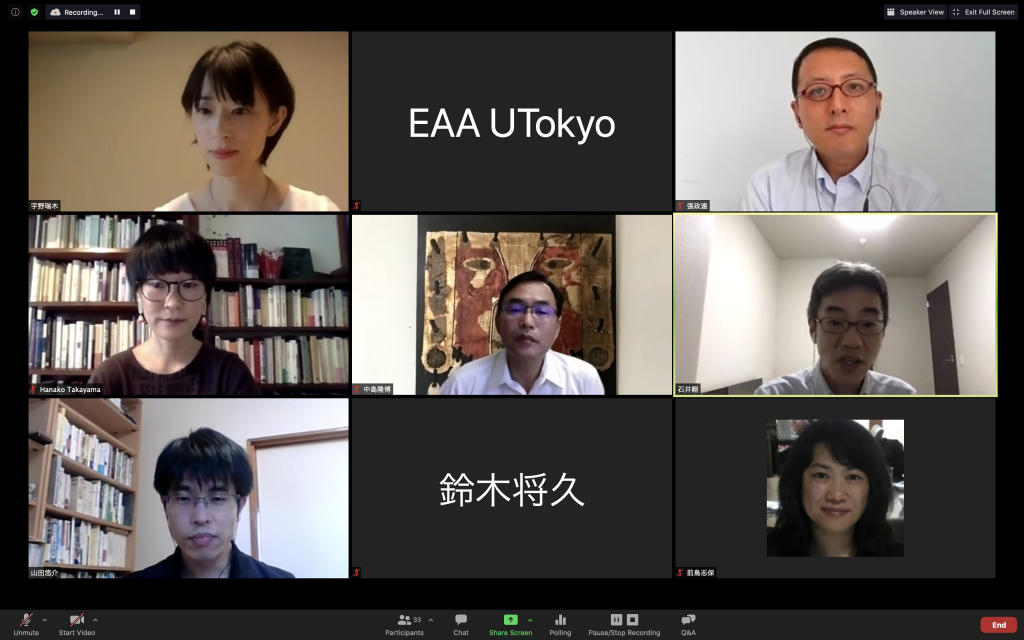
The keynote speech by Ching-yuen Cheung (The University of Tokyo) was highly suggestive regarding the concept of opening the world itself. His speech entitled “Study of Roads —Digression, Suffered Roads, and the Way of Pilgrimages” showed how to track the crossroads as if he himself is connecting several ways. I thought that became the direction to read Ishimure’s text and think for ourselves, not simply analyzing the text.
As for digressions, he explored his thinking about Koji Junrei by Tetsuro Watsuji. Philosophy might be the main road and cultural studies and the creation of novels might be digressions for him, but such a hierarchy would not be appropriate. What is important is to catch the fundamental sensitivity before the clarification of thought or sentiment.
Walking on the road and going on a pilgrimage is to think and participate in the practice in such dimension. Here we cannot overlook the fact that we have relations with multiple others on the road. The others include the past others. The act of pilgrimage has the significance to repeat and revive the dormant memory of the place. Cheung said, based on his own experience of pilgrimage, that can be seen when we are walking in the areas that suffered the 2011 Tohoku earthquake and tsunami.
For Ishimure, or for we who read Ishimure’s work, the question of this road has huge significance. Today a road might be seen as just a traffic channel. In fact, the construction of roads for traffic synchronizes with the destruction of Minamata’s nature along with the rise of Chisso. However, Ishimure tried to see the original figure of road as the expression of a hanano michi, flower road. She was born into a family of masons who landscaped the roads and knew the old road as splendid places. Then he argued that writing for Ishimure was also making roads where various people come and go and have communication.
Then we can also compare our reading of Ishimure to walking on the road. Cheung introduced the stream of performance philosophy focusing on performative aspects of pilgrimage. The performance here would be broadened to reading literary worlds. However, Ishimure’s way is not simply the flower road because we and Ishimure are already accostomed to modern roads. That might be something like karma for us. However, as Shiho Maeshima pointed out, the important thing is that there are plural roads to open. What is significant is we are walking on a road while seeking digressions and that is not the only road. What guarantees the richness of the world is the possibility of openness to several roads.
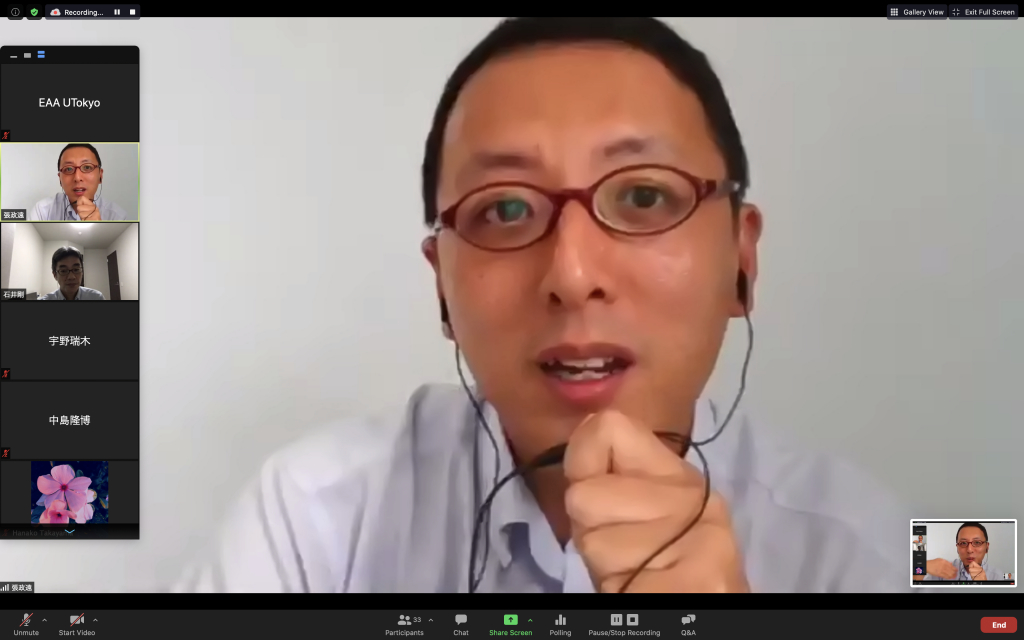
The following three presentations were all about the question of how words come into existence and what is the limit of words in analyzing Ishimure’s text. It would be good to remember that the reflective problematic —how can we read her words and talk something in responding her words? —were consistent through them.
Hanako Takayama gave a presentation entitled “When the Voice Becomes a Song — The Acoustic World of Kugai Jodo, Paradise in the Sea of Sorrow,” and analyzed how the sound, the voice, and the song are together with the words in this work. First, she remarked Ishimure’s interest in a poetic sentiment among people and her anxiety of losing them. It is true that her attitude of careful listening is described in Kugai Jodo and especially the scene of the general meeting of Chisso where Goeika was sung by patients which result in a kind of solemn stage. What we have to pay attention here is that Ishimure is not simply comparing the poetic sentiment with the loss of it, but rather is trying to have an auditory sense in face of the new sound including modern noise. And that shares Buddhist Shomyo music, whose characteristics are overlapping different voice and sound. Finding the polyphony aspect would be Takayama’s approach of reading Kugai Jodo and that would be an attitude of listening carefully to the sound tone enabled by the text itself. I personally associated this with this Heraclitus’s proverb,“What is opposed brings together; the finest harmony is composed of things at variance, and everything comes to be in accordance with strife”, as if it is a prophecy.
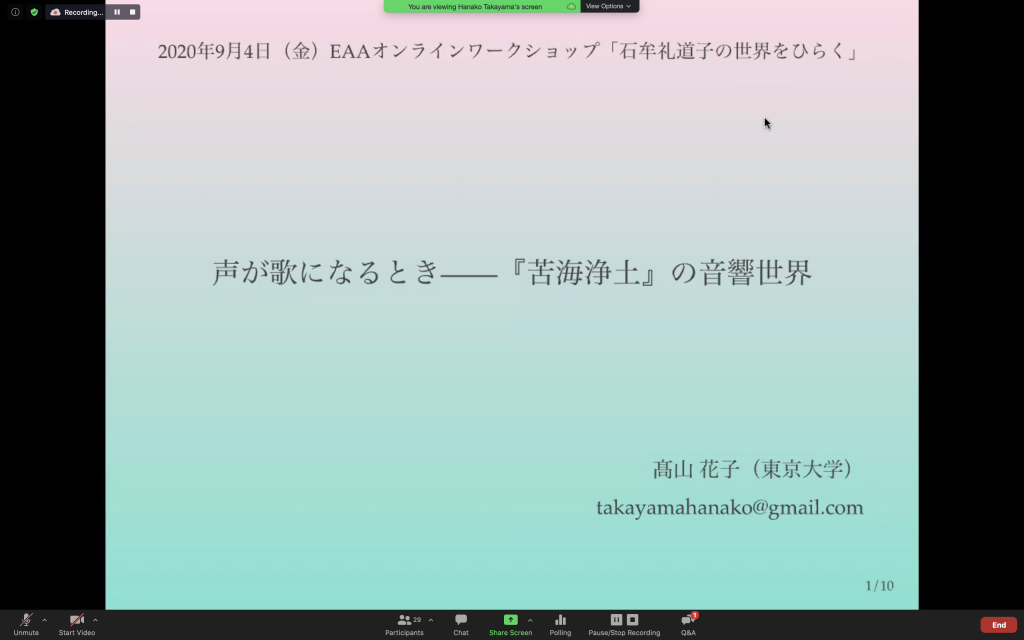
The second presenter, Yusuke Yamada (Daito Bunka University), has already written several papers on Ishimure and his book was about the rhetoric of repletion: that was our guide in reading group. He gave a presentation entitled “The Rhetoric of Pluralization — From Ayatori-no-ki of Ishimure Michiko” (it is written based on her own childhood experience and said to be creative non-fiction). Analyzing carefully the structure of narration and the way of narrating the place, he discussed how this story is realized. What was very interesting is that the expression of nature and places are followed and repeated by various narrators as if they are passing through those places, and that such natural places are no longer background nor object but rather the center of the story which makes the narrators obey. Can we find here the possibility that we are connected to the world via word? In this case, the world is not an empty and external shape, but a specific place where the concrete memory of the relationship between nature and human are accumulated. The question about the meaning of narrating old times he posed seemed to suggest how to have relations to such a creative and retrospective world.
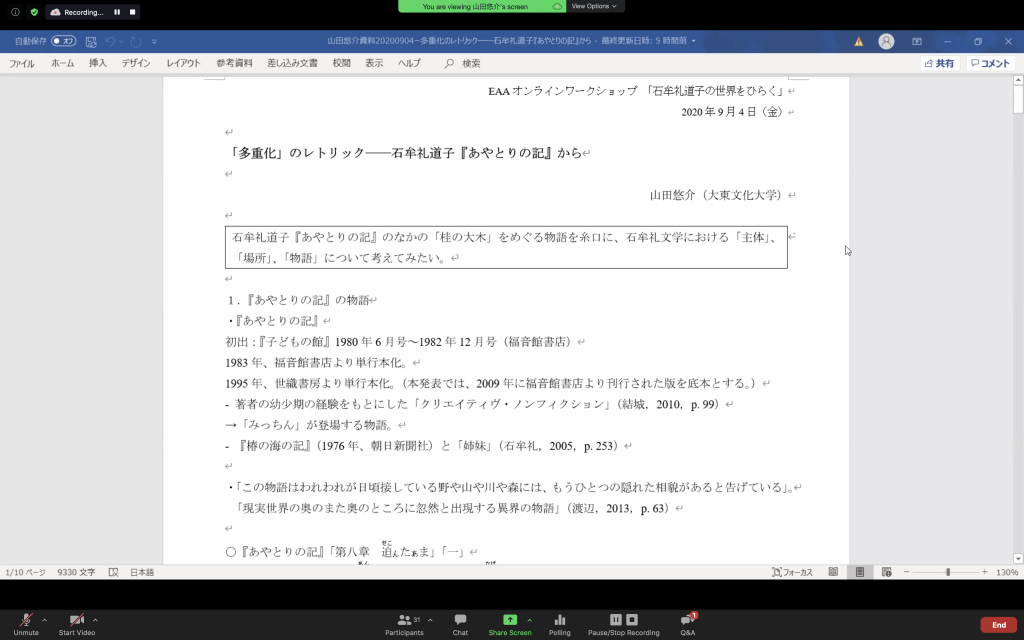
Then Mizuki Uno gave a third presentation entitled “The Meaning of the Ancient Figure in Kugai Jodo,” which examined how the ancient figure appears and what kind of significance they have from the ancient tree of Tsubaki to the ancient shrine maiden. What was significant was that she analyzed how Ishimure got related to such figures based on not only immanent analysis, but also the genealogy of the text itself. It is true that Ishimure does narrate like a shrine maiden as she wrote the soul of Minamata patients “settled into me.” However, Ishimure also worked on writing chronologically and logically of the Minamata incident before writing Kugai Jodo. She also participated in interviews in order to record local history by listening to older people’s stories. Her way of narrating is similar to the shrine maiden’s narration. For this reason, however, such shrine maiden’s narration seems to be a highly selected way of narrating. This is also similar to katari-mono in medieval times. Ishimure confessed Kugai Jodo was “like a Jo-ruri” to narrate for herself in the afterword of Kugai Jodo, and this suggests already her way of giving voice to the dead or those living who have no words because of speech disorders in a very similar way of biwa-hoshi. This is relevant to Takayama’s discussion about re-sounding. On one hand Ishimure revitalizes the voice of the dead, on the other hand, she never assimilates that voice into the living people’s order and instead makes reverberations a heterogeneous voice. Such reconsideration on the polyphony is also working on the analysis of the text itself. As Ishimure describes the scene where she encounters a Minamata patient for the first time, she seems to repeat the narration that she gave at the beginning of the story from the viewpoint of the sea and ancient trees – but this time, from her own perspective and as her own narration.
Furthermore, this polyphony is open to us readers. In the last scene of the first part of Kugai Jodo concerns a woman who cares for her brother, who is unable to walk well because of Minamata disease, and has lost her parents because of Minamata disease and she is described as shrine Maiden.This scene ends with offering cut Yokan, which is a souvenir of Tokyo, by the Chisso president, saying here you are. That is the sudden end of this story. There is no following narrative part. However, it offers something to us saying “Here you are”.
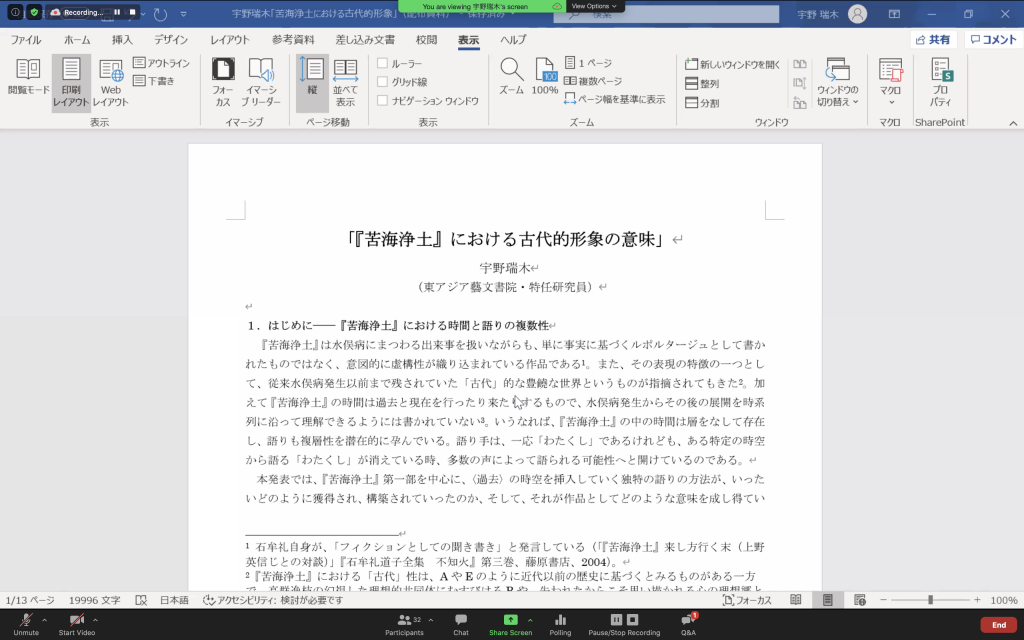
What Masahisa Suzuki (The University of Tokyo) added first as the first commenter was the importance of Gan Tanigawa who gave a inspiration of creation for Ishimure. However, we have to pay attention to their different thoughts about community and collectiveness. After this remark, he posed three questions to each presenter: 1. What does it mean for Ishimure to write unarticulated voices before the language? 2. What’s the relation between narrating old times and creating or recovering some human relationship? 3. As for the ancient, how can we think about not only time expansion, but also spatial expansion transcending the borders easily? Uno responded that in Ishimure the ancient seems somehow differentiated from the classic which is authentic. This is a very interesting point.
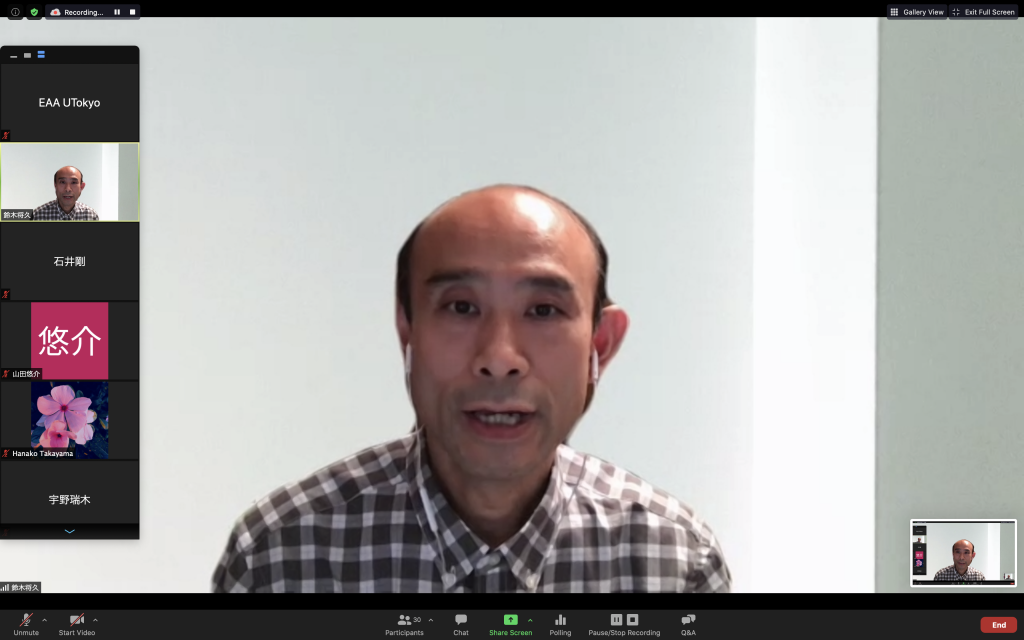 Shiho Maeshima (The University of Tokyo) pointed out that Ishimure’s works make us rethink the way of transmission, which cannot be covered in journalistic texts from the viewpoint of journalism studies. Besides that, she mentioned the possibility of reconsidering our way of life when confronted with the question of voice and sound. She used the example of the soundscape exhibition at the New York Public Library, which showed the soundscape before Covid-19 and the necessity of a new auditory sense. She said that the analysis of the multiplicity of narrating subjects in Ayatori-no-ki would be the same as the attitude of listening to the words without the words of the Minamata Patient. Finally, she wondered if there are subtle difference between medieval narration and Ishimure’s narration in regards of polyphony. She also said that the last phase “here you are” is posed to us readers.
Shiho Maeshima (The University of Tokyo) pointed out that Ishimure’s works make us rethink the way of transmission, which cannot be covered in journalistic texts from the viewpoint of journalism studies. Besides that, she mentioned the possibility of reconsidering our way of life when confronted with the question of voice and sound. She used the example of the soundscape exhibition at the New York Public Library, which showed the soundscape before Covid-19 and the necessity of a new auditory sense. She said that the analysis of the multiplicity of narrating subjects in Ayatori-no-ki would be the same as the attitude of listening to the words without the words of the Minamata Patient. Finally, she wondered if there are subtle difference between medieval narration and Ishimure’s narration in regards of polyphony. She also said that the last phase “here you are” is posed to us readers.
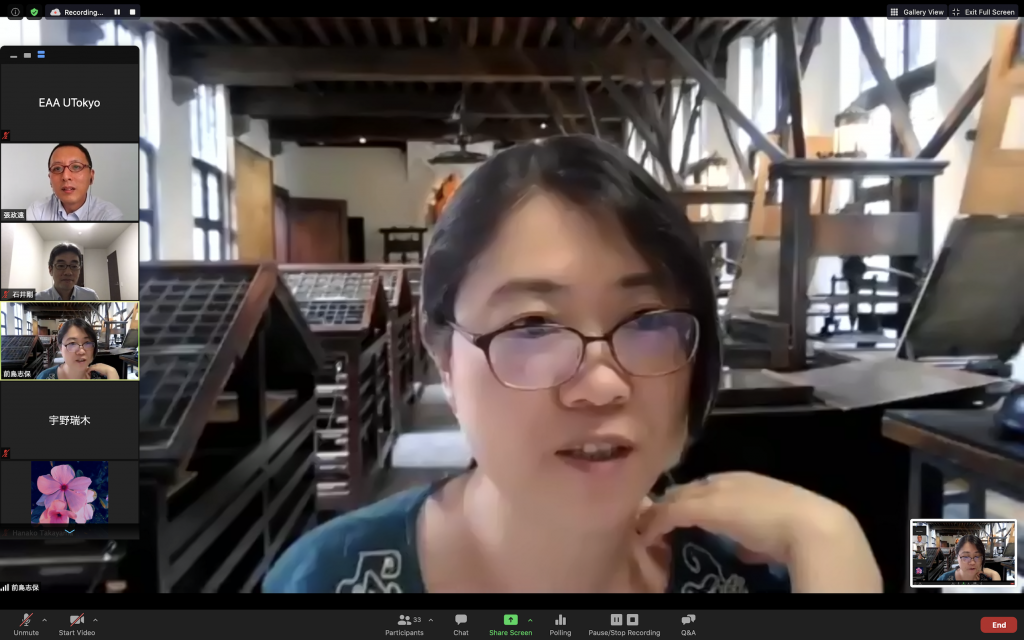
The discussion was developed so widely, including the response to the commentators and the question-and-answer session that it is impossible to cover the whole in this report. I touched upon the question concerning what is opening the world of Ishimure Michiko at the beginning and I would like to introduce what Tsuyoshi Ishii (The University of Tokyo) finally talked about regarding this. He said that Ishimure herself opens a world for us —that is typically described as the ending word, “here you are” in the first part of Kugai Jodo —, but then we have also started receiving her gift and opening anew a world and creating roads. Opening the world is nothing but walking on the road. That does not simply mean tracing the decided road, nor making freely a totally new road. It would be rather mapping out a route of exchange by acknowledging the previous road and sometimes making digressions. I felt I had somehow accomplished walking a whole complex way without losing my way thanks to the guides by Ishii and others during this workshop. This report is an analysis after these guides. Of course each has thought different things separately though we were together.
Akihiro Miyata (The University of Tokyo)
(Translated by Hanako Takayama)








